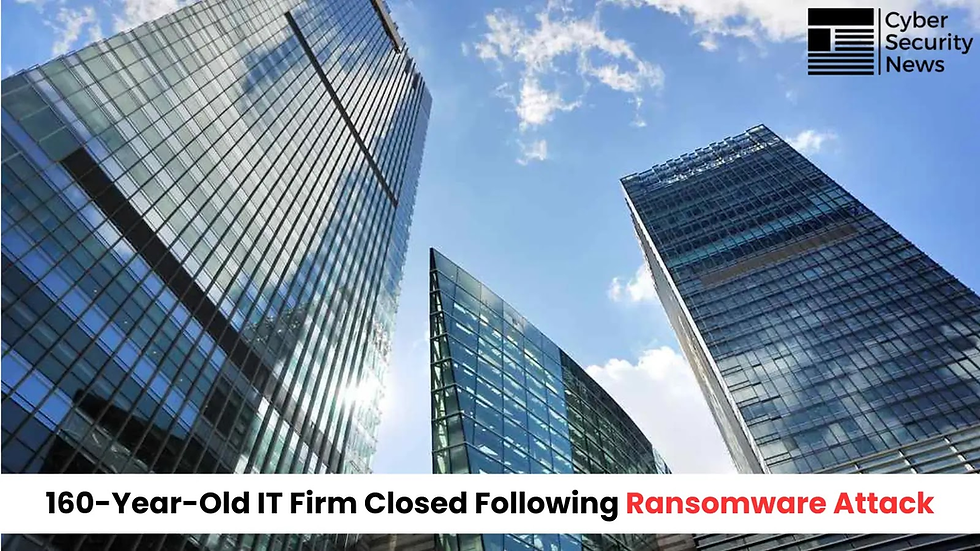Transforming a Factory's IT Systems: A Journey into Sustainable Technology and Cybersecurity Solutions
- service14526
- Jun 2
- 3 min read
In today's rapidly changing industrial landscape, factories are turning to technology to boost their operations. However, this digital shift also brings new dangers, particularly in the form of cyber threats. Striking the right balance between sustainable practices and solid cybersecurity is vital for contemporary factories. This post highlights how a managed service provider (MSP) - Sustainable IT Solutions NZ Ltd, transformed a factory's IT system with a strong focus on sustainability and security.
Understanding the Challenge
Many factories have struggled with outdated IT systems that simply cannot meet the demands of today's manufacturing processes. These legacy systems create major vulnerabilities, exposing them to cyberattacks that can lead to costly downtime and serious data breaches.
The factory faced a variety of hurdles. Inefficient resource management, environmental impacts, and the urgent need for better security were primary concerns. The goal was straightforward: redesign their IT systems to incorporate sustainable technology while ensuring robust cybersecurity.
Embracing Sustainable Technology
Assessing Current Infrastructure
The journey began with a detailed assessment of the current IT infrastructure. This involved pinpointing inefficiencies and uncovering opportunities for improvement.
The factory was heavily reliant on outdated hardware that used excessive energy. Reports showed that energy consumption was 30% higher than necessary due to inefficient machines.
Software applications operated in silos, which hampered data sharing and increased operational costs by an estimated 25%.
With the assistance of technology specialists, a clear roadmap was developed for the necessary upgrades.
Implementing Energy-Efficient Solutions
The next phase focused on deploying energy-efficient solutions that could save costs and reduce environmental impact. This included:
Upgrading Hardware: The switch to energy-efficient servers and workstations cut energy usage by approximately 40%, while enhancing performance.
Cloud-Based Solutions: Transitioning to cloud platforms enabled greater flexibility and scalability. Factories reported saving up to 20% on maintenance costs through this shift.
IoT Integration: The introduction of IoT devices allowed for real-time monitoring of machinery. This change reduced energy consumption by 15% and minimized waste significantly.

Strengthening Cybersecurity Measures
Assessing Cyber Threats
With technological upgrades underway, it was essential to reinforce cybersecurity measures. Education about potential cyber threats—including malware, ransomware, and data breaches—was critical.
Conducting cybersecurity assessments revealed vulnerabilities within the IT systems. This analysis allowed the team to prioritize their responses, focusing on the most critical areas.
Implementing Advanced Security Protocols
The deployment of improved cybersecurity measures involved:
Firewalls and Intrusion Detection Systems (IDS): These technologies formed the first line of defense, blocking 90% of unauthorized access attempts.
Regular Security Audits: Continuous monitoring and regular penetration testing kept the systems secure, with audits conducted at least twice yearly.
Employee Training: A dedicated cybersecurity training program fostered a security-conscious culture among employees, reducing the likelihood of human error by 70%.
By combining technological upgrades with strong cybersecurity protocols, the factory lowered the risk of cyber threats significantly.
Promoting Sustainable Practices Through Technology
Data Analytics for Sustainability
After implementing the new IT infrastructure, advanced data analytics tools came into play. These tools allowed the factory to:
Track energy usage accurately
Significantly minimize waste
Enhance inventory management, resulting in a 15% decrease in excess stock
By leveraging real-time data, the factory made informed decisions that promoted sustainable operations.
Eco-Conscious Supply Chain Management
Technological investments also enhanced supply chain management. With real-time data access, the factory collaborated more sustainably with suppliers, ensuring that 85% of materials procured met rigorous environmental standards.

The Results of Transformation
The transformation resulted in remarkable achievements:
Reduced Energy Costs: Energy-efficient solutions led to a 30% reduction in energy bills.
Enhanced Productivity: Streamlined operations and improved data access pushed overall productivity up by at least 25%.
Lower Carbon Footprint: Through sustainable practices, the factory cut its carbon emissions by 20%.
Strengthened Security Posture: The enhanced cybersecurity procedures secured sensitive data, protecting intellectual property more effectively.
This successful integration of sustainable technology and advanced cybersecurity measures reinforced the factory’s role as an innovative leader in the field.

Reflecting on the Transformation Journey
The journey to modernise a factory’s IT systems demonstrates the powerful impact of integrating modern technology with sustainable and secure practices. Balancing digital transformation with environmental responsibility and strong cybersecurity is essential for today’s industrial realm.
As technological advancements continue, factories must prioritise sustainability and security. The insights gained from this transformation can serve as a template for others eager to modernize their IT systems while considering their environmental impact.
In an ever-evolving tech landscape, staying proactive is crucial for ensuring both success and sustainability in manufacturing. Embracing this change can lead to improved efficiency and a greener future for all.




Comments